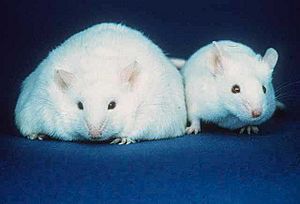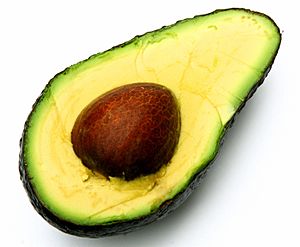Fat facts for kids
The word "fat" can also mean that someone is very overweight.

Fat is one of the three main types of nutrients that our bodies need. You can find fats in many foods. They are made of large molecules called lipids. Lipids are built from long chains called fatty acids. Some of these fatty acids are essential, meaning our bodies cannot make them. We must get them from the food we eat.
Contents
Different Types of Fats
There are three main types of fats: unsaturated fats, saturated fats, and trans fats. Each type affects your body differently.
Unsaturated Fats
Unsaturated fats are usually liquid at room temperature. They are considered "good" fats because they can help improve your blood cholesterol levels. They can also help keep your heart healthy. Most vegetable oils, like olive oil, are rich in unsaturated fats.
There are two kinds of unsaturated fats: monounsaturated fats and polyunsaturated fats. You can find these healthy fats in foods like avocados, nuts, peanuts, seeds, fish, and canola oil.
Saturated Fats
Saturated fats are often solid at room temperature. They are mostly found in animal foods, like meat and dairy products. Some plant foods, like coconut oil, also contain saturated fats. Eating too much saturated fat can lead to health problems. These include gaining weight or increasing your risk of heart disease. It's best to limit saturated fat to less than 10% of your daily calories.
Trans Fats
Trans fats are also called trans fatty acids. There are two types: natural and artificial. Natural trans fats are found in the stomachs of some animals. They are also in foods made from those animals. Artificial trans fats are made in factories. They are created by adding hydrogen to liquid vegetable oils to make them more solid.
Trans fats are considered the "worst" type of fat for your cholesterol levels. They are even worse than saturated fats. You often find them in fried foods, baked goods, and highly processed foods.
How Fats Help Your Body
Fats play many important roles in your body. They help you absorb nutrients, like certain vitamins. Fats are also a backup source of energy. Your body uses them when carbohydrates are not available.
Fats also help your body maintain its core temperature. This means they help keep you warm. Experts suggest that 20% to 35% of your daily calories should come from fat. However, too much fat can also be harmful.
Good Fats vs. Bad Fats
"Bad fats," like trans fats, have no known health benefits. They can harm your heart and overall health. Foods with bad fats are often solid at room temperature, such as butter and some animal meats.
"Good fats," on the other hand, are naturally found in foods. They do not harm your organs. Examples of foods with good fats include avocados, eggs, and nuts.
Important Fatty Acids
Unsaturated fatty acids are very important for your health. They are named based on where their double bond is located. Omega-3 fatty acids (ω-3) and omega-6 fatty acids (ω-6) are essential. This means you need to get them from your diet.
These fatty acids help build longer molecules in your body. These molecules are important for cell signaling in different tissues. They control many different bodily functions.
Eating Fat to Burn Fat
You might wonder why you need to eat fat to burn fat. Medium-chain triglycerides (MCTs) are a type of fat that can help burn fat. They are easily absorbed and used as energy by your body.
Foods like milk fat, palm oil, and coconut oil contain MCTs. Eating these can help burn fat because MCTs can increase your metabolism. A faster metabolism means your body burns more fat. Athletes sometimes use MCTs to boost their energy during exercise. MCT oil is usually mixed with water, juice, or other foods, not cooked.
Fat is important for people, even though some think it's always bad. Fat can help us maintain a healthy weight. It doesn't necessarily make us fat. The right kind of fat provides energy, protects our organs, and keeps our cell membranes healthy. However, not all fatty foods are good for you. Foods like pizza, french fries, and hamburgers often contain unhealthy fats. These can lead to weight gain and poor health.
Diet and Fats
Fats also provide long-term energy for humans. In cold places, they create a layer of insulation to keep the body warm. Fats help the body use vitamins found in foods. They are also good for healthy skin and hair.
Olive oil is a very healthy fat. Many types of fish also contain healthy fats. Examples include salmon, sardines, herring, and tuna. But if too much fat builds up in the body, a person can become too heavy. The energy from fats is used when we move around or exercise. Some vegetables, like celery or carrots, add very little fat to our bodies. While fats are very important, large amounts of the wrong kinds can be harmful.
Hidden Dangers of Fats
Eating too many unhealthy fats can lead to certain health problems. One such condition is called Fatty Liver. This happens when there is too much fat in your liver. It can be linked to alcohol use or metabolic syndrome. Fatty liver can often be improved by changing your diet and exercising more. This is one of the hidden dangers of fats.
Another hidden danger is that unhealthy fats can cause heart diseases. One example is Heart Failure. This is when the heart cannot pump enough blood. This slows down blood flow and can cause blood to build up in veins and lungs.
There are ways to avoid these issues. The first way is to exercise regularly. Being active is always good for your body. The second way is to eat healthily. You need to keep a good balance of nutrients in your body. Also, eating enough protein can help your body manage fats.
Images for kids
-
A typical triglyceride molecule, which is the main type of fat. Notice the three fatty acid chains attached to the central glycerol part.
-
The overweight mouse on the left has large stores of adipose tissue (body fat). For comparison, a mouse with a normal amount of body fat is shown on the right.
-
Margarine is a common product that can contain trans fatty acids.
See also
 In Spanish: Grasa para niños
In Spanish: Grasa para niños












